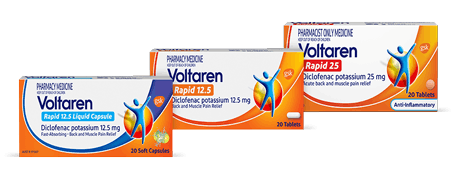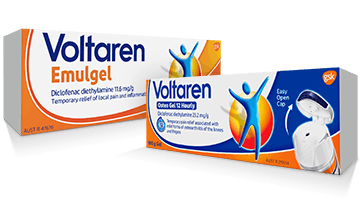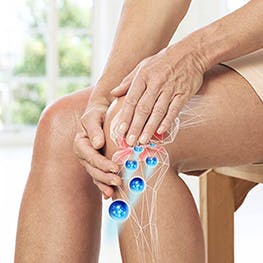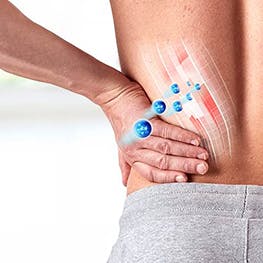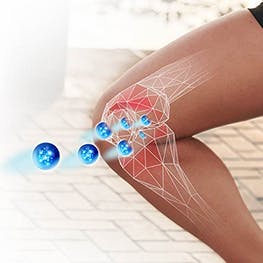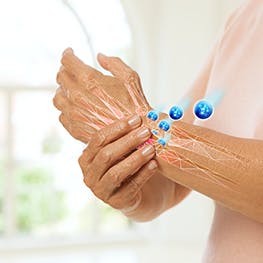If you have been experiencing ongoing pain for months on end (first of all, we’re sorry to hear it!), you may be experiencing chronic pain. What is chronic pain? Chronic pain is pain that lasts for longer than the expected time of healing for an injury, typically three months or longer.
Being in chronic pain is no fun. Plain and simple. It can be a huge distraction. It can make you pull back from doing things you enjoy and seeing people you love. In fact, chronic pain is strongly linked with lack of sleep, fatigue,... loss of productivity.1 78% of people who experience pain report a decrease in quality of life.2
Educating yourself about chronic pain can go a long way in helping you manage it so you can regain some joy in your everyday movements.
Chronic pain can affect anyone of any age or demographic. For better or worse, pain affects all of us at some point in our lives. In fact, chronic pain affects one in five, or about 1.5 billion people of the world population in 2020.3 By understanding what pain is and where it’s coming from, you can stay one step ahead of it.
Symptoms of chronic pain
Chronic pain symptoms vary depending on what the underlying cause is.
Direct symptoms associated with chronic pain include4:
- Stiffness
- Swelling
- Inflammation
- Soreness
- Throbbing
- Dull aches and pains
- Stinging or burning...
Chronic pain can often affect your quality of life. Being in pain can make it difficult to fall asleep and stay asleep. Being sleep deprived can make it harder for your body to regulate its pain response. In other words, insomnia can make your pain feel worse as well as make pain last longer.5
Chronic pain can hold you back from participating in activities that you once loved. It can change how you view yourself and alter your self-esteem. This is why chronic pain can lead to mood changes.
Indirect symptoms associated with chronic pain include6:
- Insomnia
- Fatigue
- Weakness
- Mood changes
- Lack of appetite

Causes of chronic pain
What causes chronic pain? Chronic pain is typically caused by an underlying and ongoing chronic illness.
Chronic pain can also be caused by previous injury, possibly from resulting nerve damage. In some cases, however, people may experience chronic pain without previous injury or illness. The reasons for this kind of chronic pain are not well understood.7
Ongoing joint pain or conditions like osteoarthritis are examples of chronic pain. Acute pain, on the other hand, is categorized as sudden and severe discomfort. So, if you cut your finger with a knife while pretending you’re the next Top Chef, don’t fret. Painful injuries like these usually go away within a relatively short period of time.
Risk factors for chronic pain include:
- Previous injury
- Previous surgery
- Being female8
Women present more often with chronic pain than men do, although researchers are still working to figure out why.9
Visit your healthcare professional to best understand what causes your chronic pain. Together, you can tailor a path of treatment that works for you and addresses your underlying causes of chronic pain.
Management of chronic pain
Managing chronic pain can help you regain your joy of movement, so you can feel a little bit more like yourself again.
See your healthcare professional for medicated chronic pain relief options.
There are lots of things that can help to keep you moving without medication. Non-medicated chronic pain management can include:...
- De-stress
Stress can make chronic pain worse.10 Relaxation techniques may help you reduce stress in your life and might help to lessen pain.11 They may also improve your quality of sleep, which has a large impact on chronic pain.12 - Self-care
Eating well and maintaining a consistent sleep schedule can contribute to overall wellness. Maintaining a healthy body weight can take physical strain off your body, thereby helping to ease pain. - Physical therapy
Physical therapy, using techniques such as stretching exercises and massage, may help ease chronic pain. This can help to strengthen the muscles around your joints, which will help support them and prevent problems. The goal of physical therapy is to increase your strength and flexibility gradually, so you get back on your feet.13 - TENS
TENS stands for transcutaneous electrical nerve stimulation. It is a tool often used by doctors and physical therapists alike to help block chronic pain signals to the brain using electrodes attached to the skin, relieving your pain without additional medication.14 - Light exercise
Light exercise can strengthen your muscles, relieving pressure on your joints. This can help decrease pain in your joints.15 One of the benefits of light exercise is that it reduces the risk of and can improve symptoms of chronic disease, like back or joint pain.16 - Stretching
Stretching keeps your muscles loose, which can relieve pressure on your joints. A regular stretching routine can keep your muscles strong and healthy, resulting in increased range of motion.17
If your pain isn’t serious and is a type that you and your health care provider deem can be managed yourself, it’s important to get on top of it so it doesn’t hold you back from getting on with life. That way you can regain a sense of yourself and once again enjoy doing the things you love.
Relief options by pain type
Learn all about the causes, symptoms, and pain relief options for the type of pain you’re experiencing so you can get back to doing those little things that bring you joy.





